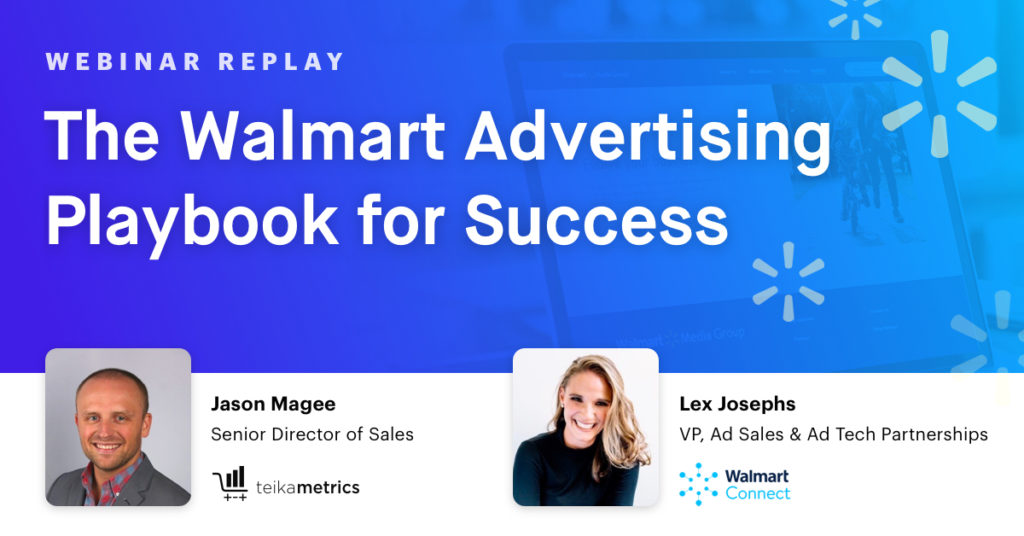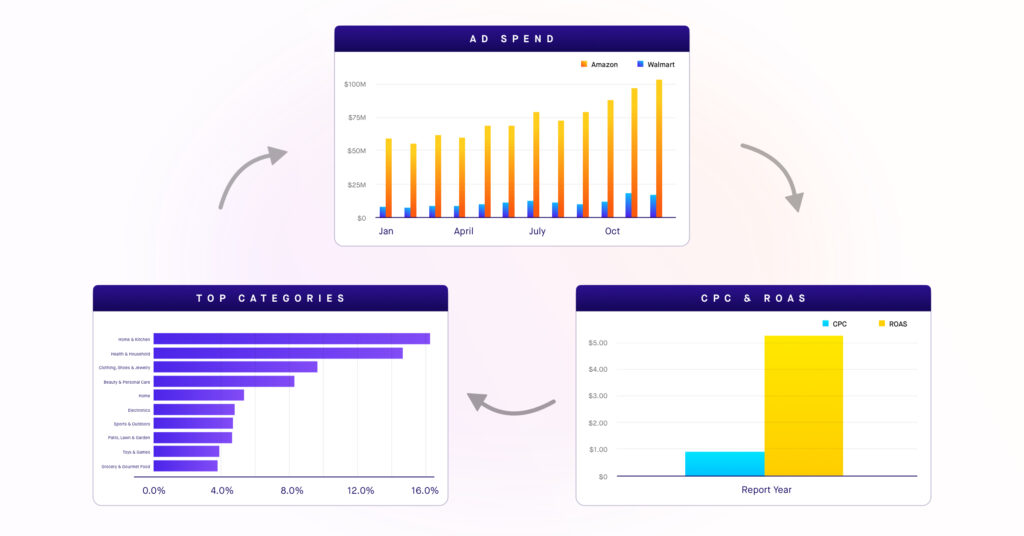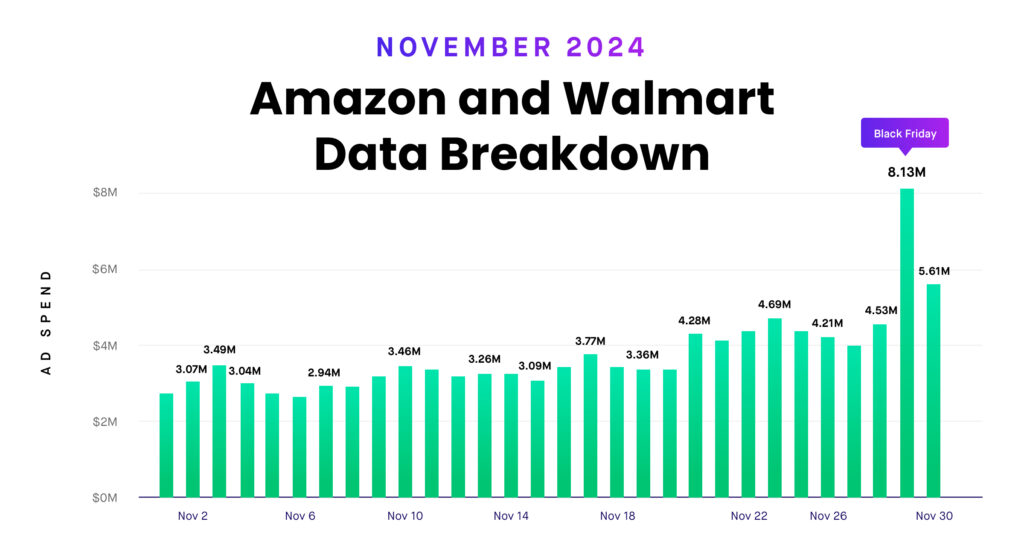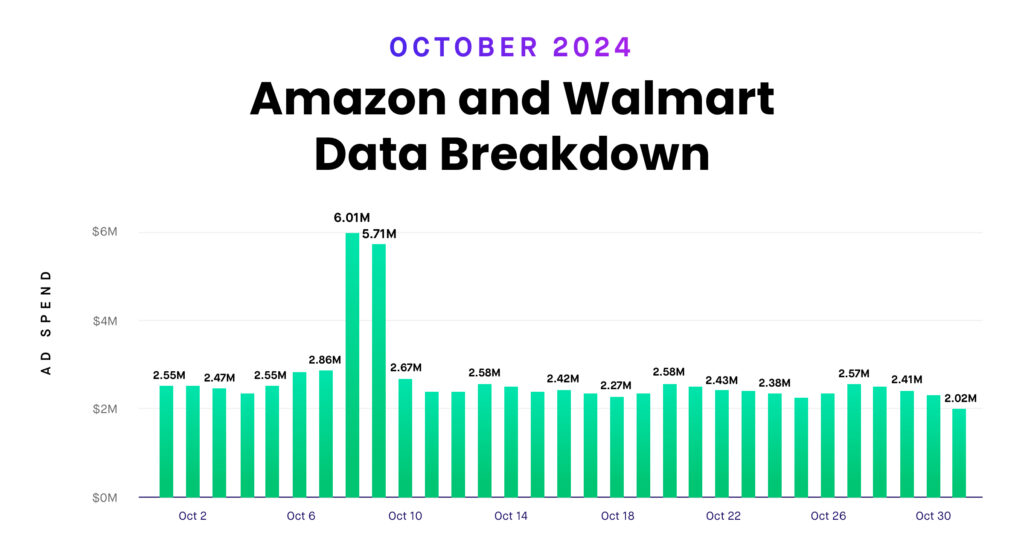Walmart is the largest retailer in America and the second-largest online retailer. That reach creates huge opportunities for sellers. But in order to take advantage of this huge platform, sellers need to have a solid advertising strategy. In this webinar, Lex Josephs, VP of Ad Sales & Ad Tech Partnerships at Walmart Connect, and Jason Magee, Senior Director of Sales at Teikametrics discuss the necessary steps to seller success on Walmart.com. They explain how to advertise on the platform, the tools available to optimize your ads, and how to gain an edge over your competition.
Webinar Takeaways
- Succeed with sponsored products
- Unlock the power of 4 high traffic ad placement types
- Optimize campaigns with keyword performance tools
- Utilize additional reporting tools
- Set product goals and track the right metrics
- Choose which SKUs to grow
- Get retail-ready
- Figure out your organic performance
- Prioritize quick fulfillment
- Take advantage of seasonal events
- Experiment with bids to increase profit
Show Links
- Check out Walmart Connect
- Connect with Lex Josephs on LinkedIn or Twitter
- Check out Teikametrics
- Connect with Jason Magee on LinkedIn
- Connect with Teikametrics on Twitter or LinkedIn
Watch the Replay
Key Teika-ways
14:28 – Succeed with sponsored products
Lex said that a sponsored product campaign puts your product in a prime position to be discovered by consumers.
It’s important that you are live a minimum of 30-60 days before you start a sponsored product campaign. A sponsored product campaign will help you capitalize on ecommerce and commerce growth, own search, drive discovery, and win at Walmart as a well-managed Walmart advertising strategy that will be essential for your long-term marketplace success. Many people have said, Lex, that’s great, but what is sponsored products? So I’m here to share with you. Sponsored products are ads that help customers discover relevant products as they search and browse on Walmart.com. Ads appear on our site in prominent high traffic spots, such as search results, product detail pages known as PDPs, and the Buy Box. It allows you to get noticed, increase sales, and control costs. And as a marketplace seller, there is no fee or set up costs. You are only paying for when a customer clicks on your ads.”
15:40 – Unlock high traffic placements
Lex said when you start a sponsored product campaign, there are 4 placement types where your product ads may appear: Search in Grid, product carousel, Buy Box, and pickup & delivery.
“The Search in Grid highlights your product on the first page of results when customers search relevant keywords. These ads send customers directly to your product page. Another feature is our product carousel. So our product carousel ad highlights your product on results pages and on item pages for similar or relevant products. This is a great way to target customers based on their category browse behavior, or drive traffic to your product pages and close the loop. Another feature is our Buy Box. Our Buy Box is a premium placement that captures Walmart customers as they make their final buying decision by highlighting your product in a premium, high visibility placement on item pages for similar products. Lastly, we’ll talk a little bit about placements on pickup and delivery. We have placements within our pickup and delivery experience. This is our homepage example, highlighting our feature item carousel placement, which is a premium placement that drives wide visibility. It’s also hyper-local and ads automatically populate with products based on their regional search frequency, store availability, and bid price.”
17:14 – Optimize campaigns with keyword performance tools
Lex said Walmart has campaign reporting tools that let you measure many different metrics. The first tool is a keyword performance report to help with Search in Grid ads.
“Through our reporting you can measure impressions, clicks, ROAS, and ad spend. We also have something called on-demand reporting. And this provides you with many opportunities actually for optimization. They also provide insights and suggestions. So some of the areas that we’re going to talk about are specifically around four different types of reports. The first is our item keyword performance report, which is also a search harvesting tool. This report indicates which keywords your advertised items are being served against and how well the advertised items are performing for those keywords. This information can help you to improve current and future sponsored product campaigns. For automatic campaigns, we use this report to identify keywords that show your ads in Search in Grid placements and deliver high performance. You can add these keywords to various campaigns. You can use this additional information to optimize campaigns and you can bid on higher and more valuable keywords and/or remove underperforming items.”
18:15 – Utilize other reporting tools
Lex said that campaign reporting tools also include keyword performance, placement performance, and an item health report.
“The second type of report is our keyword performance report. This report indicates which keywords your advertised items are being served against, and the information can also help you optimize against your keyword bids. We also have a placement performance report for keyword bidding campaigns. This report allows you to view key metrics like CTR, conversion, ROAS, and more for your specific keyword campaigns by the placement the ads served in. This information can also help you improve current and future sponsored product campaigns using the bid multiplier to optimize placements based on reporting. Lastly, we have the item health report. Think of this almost as your inventory status. This report provides a more streamlined way of viewing various aspects of your advertised items that include signals such as item availability, Buy Box win rate, whether an item is published or is based or variant, etc. along with many recommended actions to improve the health of their items, as well as optimizing your campaign. If you notice your campaign is struggling to spend or is inconsistently spending, it’s possible your items are not always in stock. So this is a good report to check your inventory status.”
21:44 – Set product goals and track the right metrics
Lex said the first step is to determine what your goals are and what success means to you. Then, keep an eye on the metrics that will best tell you if you are succeeding.
“With performance and sales, the key metrics you would be focusing your campaign around would be return on ad spend, known as ROAS, and sales revenue. It’s incredibly important to take into account that not every SKU is offered both in-store and online at an omnichannel retailer like Walmart. So please do take that into consideration. Another example is brand awareness and higher impressions. This category is all about getting as many eyeballs as possible for your product and brand. This is especially important for large brands with a high volume of SKUs. You want your brand to be front and center through a customer’s entire Walmart journey. So the metrics that your campaign is focused on are impressions, clicks, and ad spend. It’s very important. And it’s a great opportunity to capture new customers who aren’t already brand loyal.”
22:24 – Choose which SKUs to grow
Lex said you can set a goal of SKU growth and track those metrics. It’s important to choose a long-term strategy for your products.
“Another example I’m going to provide you as a goal is growth of SKUs. This one requires the most patience and staying power, but growing SKUs can be an essential investment for brands looking to build a rock-solid foundation for success and even reap organic benefits. If your SKUs lack reviews and online ratings, this is where you want to play. With so much competition out there, it’s all about getting customers to interact with your SKUs and being in it for the long haul. So key metrics include clicks, units sold, and conversion rate. The types of SKUs to focus on could be new SKUs to Walmart.com and SKUs with low performance. And when it comes to selecting the right SKUs to advertise, again, don’t take the ‘set it and forget it’ approach. As more competition continues to enter the marketplace, it’s very important for you to ever and continually optimize and support a very long-term advertising strategy.”
28:39 – Get retail-ready
Jason said that before you launch a campaign, make sure your content, images, and categorization is done well and in place.
“You have to make sure that you are categorized correctly. You can do this in Retail Link. You can also do this direct with your seller center. But the other thing too is look at the quality of their images. Just incredible images that you see here as well. If you scroll down, what I was very impressed with is how they’re using their space and really making sure that us as consumers know what we’re getting ourselves into down to rich media here as well. All of those are important. The reason why these are important even beyond advertising is if Walmart is trying to index you and they want to make sure that they know which search terms your products are associated with, they need to have data to pull from. So it’s very important that you make sure that you do this not only for organic, but even for automatic campaigns. They need to have a deep Rolodex of search terms and phrases that are relevant to your product.”
29:57 – Figure out your organic performance
Jason said that sellers should find out how products rank organically, then approach each SKU individually depending on what they need.
“You need to take a deep accounting of where your products rank organically on top search terms. Reason why, I love this about Walmart, they’re only going to show your SKU once per page. So you’re not going to see a scenario where it’s cluttered with ads and you see the same products organically as well. The way Walmart’s built it is if you’re going to advertise, that ad placement is only going to better where you rank organically. So you have to be very strategic as Walmart opened up their Search in Grid placements. As an example, it used to be only in the top two rows, slots 2, 3, 5, and 12, or 6 and 12. Now that they are throughout the entire page one, you have to be strategic of, Hey, you know what? I’m ranking so well organically, maybe ads isn’t the right strategy. Or maybe you have to adjust your strategy.”
32:37 – Prioritize quick fulfillment
Jason said that sellers with fast fulfillment times have much higher conversion rates.
“You have to get fulfillment correct. You have to get it set competitive. Not only does Walmart want to make sure that they have good caliber sellers that can fulfill on-time—customers are super sensitive to how you deliver, especially how quickly you can do so. What I wanted to share as an example, when we did a webinar with Walmart Marketplace team previously, they actually shared this, which is how quickly you can ship an item and get it delivered. How can that impact your conversions? Well, the beauty here is if you’re using Walmart fulfillment service or you have two-day shipping, or if you’re 1P or Walmart’s pick packing and shipping your items, having that two-day shipping time can increase your conversion rates an average of 41.2%. So if you think that you’re putting your best foot forward and you don’t have delivery expedited and really dialed in, you’re missing massive amounts of sales and exposure.”
37:38 – Take advantage of seasonal events
Jason said Walmart pushes a lot of seasonal events to drive sales. Have your research and goals in place so you can get the best return on ad spend.
“Walmart’s constantly rolling out events. You obviously have Earth Day events. You have September for baby. You have back to school. There’s so many opportunities to make sure that you can take advantage of the heightened search volume that’s coming through. Going dark can be killer. Search isn’t always on strategy. And then as I just mentioned, going deeper. Conversion rates are arguably the canary in the coal mine before you even look at return on ad spend. We all know it takes days on any platform to dent for ROAS and ad sales to be attributed. Focus on conversion rates. If you start to convert higher, you actually could increase your bids, knowing that you’ll still stay within your desired ROAS because you’re converting much higher. So you need to make sure you’re following conversion rates and taking into account how, if you’re going to convert higher, you can still meet and exceed your ROAS targets.”
44:55 – Experiment with bids to increase profit
Jason said Walmart is a first bid auction, so the highest price wins the bid. To make sure you’re maximizing your ROAS, experiment with different bids and both manual and automatic ad campaigns.
“First Price Auction means that you need to make sure that you’re testing out higher bids, but just because you’re sitting at the top of the win with a top bid doesn’t mean you can’t be winning at a lower price point. Maximize efficiency and profitability at the exact same time, as Lex said. Explore and exploit strategy with automatic and manual campaigns. However, know that automatic and manual campaigns have different advertising inventory. Manual campaigns, you have Search in Grid and carousel. On automatic, you have Search in Grid, carousel, category pages, Buy Box pages. So it’s always good to have automatic campaigns running, because you have increased opportunity to get exposure in more placements to win. Platform-specific targeting. There’s something that makes me so giddy about what you’re able to do on Walmart. Sellers can see performance by platform sites and paid sites. And you can actually leverage bid multipliers.”





